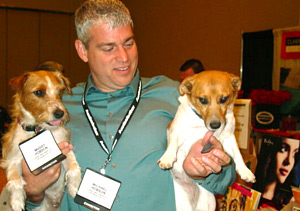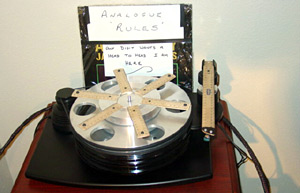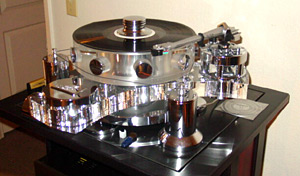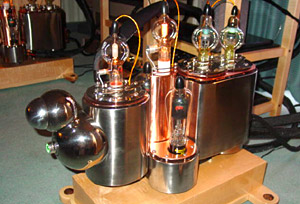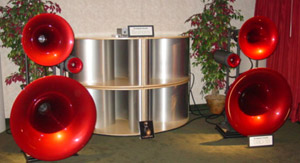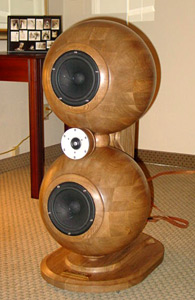![[SoundStage!]](../sslogo3.gif) Audio Hell Audio HellBack Issue Article |
||||
February 2003 A Hell of a Show You’ve gotta get the socks right. That’s the best advice I can give after spending nine hours a day walking from room to room listening to the best audio exotica the world has to offer. It doesn’t matter if you are a world-class tonearm designer, like Frank Schroeder, or a captain of thermionic emission (that’s tube activity for all you transistor folks out there), like Dennis Had. You’ll still find yourself sitting on some steps or in a chair in the hotel lobby, rubbing those metatarsals, wishing for a pair of interchangeable feet. Glamorous, isn’t it? It was with this in mind that I proceeded to pack a total of not five, not eight, but a dozen pairs of socks for my four-day expedition to CES 2003. As my wife stood by the bed calling the psychiatrist to ask advice on the best medication for obsessive-compulsive disorder, I calmly explained about the sock situation. You must take into account which pair of shoes you are wearing, color of pants, foot swelling quotients, and temperature outside, not to mention the issue of cotton or wool and moisture-wicking capabilities. OCD? I think not! Just a little precautionary packing. Upon landing and obtaining proper transportation (blue PT Cruiser -- not my thing), it was off to Alexis Park, site of the high-end audio rooms of CES. What many audiophiles fail to realize is that the high-end audio portion of the Consumer Electronic Show is a mere microcosm of the whole event. Yes, by navigating your way to various locations you can check out everything from the latest lighting for discotheques to vibrating massage chairs. And speaking of vibrating, we shouldn’t forget that there is also a part of the convention dedicated to adult entertainment as well, complete with porno princesses posed as spokesmodels. I, of course, wouldn’t know about such things. Along with CES, there is also a second high-end show going on in a nearby location. It’s called T.H.E. Show and stands for The Home Entertainment Show. Prices for exhibitors are rumored to be a bit lower, but the quality of the goods is just as high, if not higher, than what's shown at CES. For economy of words, when I use the word "Show" in this report, I may be referring to either location. The ballroom at Alexis Park always pulls me in like a magnet and is a required first stop. What makes the ballroom so irresistible is the large number of music retailers selling CDs, DVDs, SACDs, and most importantly LPs at discounted prices. Yes, I know -- I’m supposed to be there to indulge my auditory senses in the latest and greatest, but who can resist reissues of old RCA shaded dogs at $12 a pop. I even saw some real shaded dogs at the Classic Records booth. Hey, it only takes 15 minutes or so, then it’s off to the races.
I must admit that after having attended the high-end show several times, I've become a little jaded. It becomes harder and harder to find something that really catches your ear. I know, I know -- I can hear some of you now. "Poor guy has to endure such drudgery." I’m not trying to complain -- really. The CES truly is an audiophile’s dream world, and if you ever get the chance to go, don’t hesitate. Even for the veteran attendee, there is plenty to get excited about. I guess the thing that had me jumping up and down the most was the amount of analog gear at the show. In the previous couple of years, SACD players seemed to be on the rise as the preferred source component in many rooms. This year the number of high-rez players seemed to be down, but turntables, on the other hand, were everywhere. Nottingham, VPI, Clearaudio, Rega, Transrotor, Immedia RPM, Roksan, Garrard, Amazon, DPS, EuroLab, and Origin Live are only a few of a long list of 'tables spinning vinyl at the show. The V.Y.G.E.R. turntable stood like a polished stainless-steel oil derrick in a couple of rooms at the show. Priced at $26,000, the V.Y.G.E.R.’s platter and linear-tracking tonearm are both driven by air. As mighty as this free-standing beast appeared, it was the little tabletop cousin that caught my eye. Only $16,000 -- how about two? As for analog eye candy, my award would have to go the Transrotor Tourbillon, a sculpture in acrylic and chrome that captured my eye to such an extent that I can’t remember how anything in that room sounded. I guess it’s a good thing that this one, at $25k, is a little out of my budget as well. I’d never pay attention to the music. Getting back down to earth for a moment, the newest design by Nottingham Analogue looks to be a real gem. It's priced right at $1000 with a Rega RB250 tonearm; I predict the Horizon to be a real winner. The 'table shares much technology with its much more expensive relatives and looks good to boot. As always, I really enjoyed talking with Mr. Nottingham himself, Tom Fletcher. Learning that I was from Kansas City, he preferred to talk about some of the great jazz that came from my neck of the woods. Tom has a real knowledge of music as well as a great love for it. I always seem to prefer products more that are designed by people who talk music first, machines later. For those of you more comfortable with binary coding, there was plenty of digital gear to get excited about as well. High-end universal audio/video players are finally starting to eke out slowly. Bel Canto was showing an $8000 beauty that is said to incorporate components from their well-reviewed DAC2, giving superb Redbook CD playback as well as SACD and DVD-A. Perhaps what grabbed my attention most was the universal player from McCormack, now teamed up with tube legend Conrad-Johnson. At under $3k, the UDP-1 sounded fantastic to my ears in all formats, stereo and multichannel. McCormack was also showing their multichannel analog preamplifier, the MAP-1. More and more companies are choosing to offer multichannel analog preamps, leaving the processing to the source components. This allows the benefit of quality SACD, DVD-A, DVD multichannel playback without mucking up the stereo signals for high-end two channel.
For pure unadulterated tube lust, I can think of no products lustier than those retro pieces of art by a company appropriately named Electronluv. Describing these as the most unique-looking amplifiers I have ever seen doesn’t begin to do them justice. These amplifiers look like a cross between the bumpers of an early '50s automobile and a death-ray machine from a '60s sci-fi B-movie. Chrome, stainless steel, and copper combine with some very peculiar tubes that emit glows of blue, orange, red, and yellow. The man who builds these, Josh Stippich, is definitely an artist. I caught a glimpse of his hands, which were covered with cuts, scrapes, and burns. I could just picture him, welding torch in hand, crafting these unique sculptures one at a time. Art meets audio. Unison Research, already getting kudos for their little tube-hybrid integrated amplifier, the Unico, is expanding the Unico line. The company was showing a matching tube-hybrid CD player, a hybrid stereo amp, and perhaps the most unusual component: an eight-channel hybrid power amp. Now that’s multichannel audio I can get excited about! Tenor Audio, which made quite a stir last year with their big wood-trimmed OTL tube amps, also jumped on the hybrid wagon. Their 150 Hps is a stereo model that will deliver 150Wpc. The 300Hps is a 300-watt monoblock version of the same amp that can deliver up to 1200 watts into a 2-ohm load. Who says you can’t have your cake, I mean tubes, and -- you know what I mean. The cake doesn’t come cheap at $18,000 for stereo and $30,000 per pair for mono amps. Speakers are always the focus when you walk into any room. With any luck, the speaker manufacturers have teamed up with component manufacturers that make both products shine as a system. This is not always the case, and I’m quite sure that more than one great speaker gets a poor showing because of poor system synergy. Nevertheless, there were plenty of great-sounding speakers at this year’s affair.
Winner of the Dr. Seuss musical-instrument award goes to the Avantgarde Trios with Basshorn accompaniment. If you really want to see your spouse turn from sweet and demure to something closer to Gene Simmons from Kiss, try the following experiment: Show her this photo and inform her that you have the complete outfit on order but need to know if she prefers red metallic or zenith blue. I must admit that the dynamics were incredible. The bass, flat to around 18Hz, made me glad that I hadn’t eaten yet. Another horn that caught my ear was the coppery-colored beauties in the Moondog Audio room. Played through a pair of their single-ended-triode amps, I have never heard Steven Stills sound so there. It’s very hard to build a horn speaker that doesn’t sound, well, horny. Often they sound like a slightly less objectionable version of the speakers you find in football stadiums. But when they get it right, they can be downright scary in their immediacy and conveyance of microdynamics. One of my favorite little speakers at the show was manufactured by a company known for its horn speakers, but it was not a horn. Calix Technology of Taiwan is known for the Phoenix, a big monster with a large adjustable horn on top. When I walked into the room I was immediately seduced by what I heard as music being played. I didn’t hear a speaker. In fact, I wasn’t sure which of the four models they had set up in the front of the room was playing. As deep as the bass was, I was sure it had to be one of the large models. I was quite surprised to find that I was listening to the little F2, a $1500-per-pair minimonitor.
Some of the speakers shown this year really had balls. No, I’m not being crude here -- they really had balls. MuRata, a Japanese company better known for capacitors and resistors, was showing a "spherical ceramic speaker." MuRata says that spherical ceramics have a "breathing vibration mode" that "gives free listening position and real live music." OK. Artistic Audio is another company with a bias toward balls. Their Mobius is a modern-looking tuning fork with a pulsating sphere wedged between the prongs. Their sphere is actually made up of twin 8" dome-shaped midbass drivers mounted back to back. Hailing from Belarus in Eastern Europe is Sound-e-Motion, a speaker company that must keep many a woodworker busy at his lathe turning out substantial 40cm wooden balls for speaker enclosures. The old becomes new again with the Oscar A.V.T speakers, which use the old Heil Air Velocity Transformer for everything around 1000Hz and up. I was mightily impressed by the Syrinx, a model that sloped the top of the cabinet containing the midbass driver and concentrically aligns the A.V.T. driver facing forward. This little floorstander gave wall-to-wall soundstaging with large symphonic music. Globe Audio Marketing also delves into the classic realm with Classic Quads. These are not the new Quad 988 or 989, but the old classic ESL 57 variety that so many can share fond memories of. They were showing a pair of "stacked Quads" made from stacking the "guts" of two pair of ESL 57s. Talk about pure midrange -- goosebumps. Best of Show? Everyone always wants to know. What were your top picks? Who had the best sound? Who knows? Did I have my favorites? Of course, and I’ll share those with you in a minute. But what’s important to understand is that judging audio products under show conditions is like judging a painting under very dim lights. You can get a feel for what the product can do, but it’s really not conclusive. That being said, there were two rooms that pulled me in and didn’t want to let go. The first was the Orpheus Labs room playing through StudioLab Reference Revelation speakers. The Orpheus Laboratories Model Two multichannel preamplifier was well reviewed by Jeff Fritz in November and received the SoundStage! Edge of the Art award for 2002. Also in the system was a pair of Orpheus Three 150-watt monoblocks and the newest Orpheus component: a CD player/transport, the Orpheus Zero. Boy, these Swiss sure have a way with naming components. Names aside, the sound produced in this room was captivating: a deep, solid foundation, pure midrange, extended airy highs, wrap-around-and-slap-you-in-the-back-of-the-head soundstage. And it’s all solid state! What’s wrong with me? Still, I visited this room at least three times. My other pick, and probably my favorite room, I only visited once. This was the Herron Audio room. It was on the last day. It was near the end of the day. I don’t know how I missed it before, and this saddens me. I went in, sat down, and Keith Herron put on a 45rpm version of Louis Armstrong playing "St. James Infirmary." Equipment included a Herron preamp that looked like the tubed VTSP-1A. Rumor has it that it was actually a new solid-state model housed in the tubed-unit's chassis. Source was a VPI 'table played through the Herron tubed phono stage. Speakers were Joseph Audio Pearls powered by the Herron M150 monoblocks. As tired as I was, as sore as my body felt, it just all went away with the first raspy sounds of Satchmo’s voice. I became one with the sofa. I didn’t want to leave -- ever. And then my cell phone began to vibrate. Reality really does bite sometimes, but those few minutes made the entire Show for me. Right amps, right cables, right speakers, right 'table, right 'arm, right cartridge, right room, right atmosphere -- who knows? But it sure came together here. As I packed to return from my yearly pilgrimage, I realized that seven pairs of socks were still clean, but don’t tell my wife. You can never be too prepared. Come to think of it, these socks are feeling a little too thick. ...Bill Brooks
|
||||
|
||||
![[SoundStage!]](../sslogo3.gif) All Contents All ContentsCopyright © 2003 SoundStage! All Rights Reserved |
